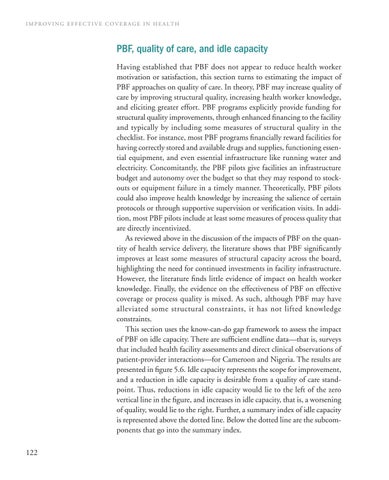IMPROVING EFFECTIVE COVERAGE IN HEALTH
PBF, quality of care, and idle capacity Having established that PBF does not appear to reduce health worker motivation or satisfaction, this section turns to estimating the impact of PBF approaches on quality of care. In theory, PBF may increase quality of care by improving structural quality, increasing health worker knowledge, and eliciting greater effort. PBF programs explicitly provide funding for structural quality improvements, through enhanced financing to the facility and typically by including some measures of structural quality in the checklist. For instance, most PBF programs financially reward facilities for having correctly stored and available drugs and supplies, functioning essential equipment, and even essential infrastructure like running water and electricity. Concomitantly, the PBF pilots give facilities an infrastructure budget and autonomy over the budget so that they may respond to stockouts or equipment failure in a timely manner. Theoretically, PBF pilots could also improve health knowledge by increasing the salience of certain protocols or through supportive supervision or verification visits. In addition, most PBF pilots include at least some measures of process quality that are directly incentivized. As reviewed above in the discussion of the impacts of PBF on the quantity of health service delivery, the literature shows that PBF significantly improves at least some measures of structural capacity across the board, highlighting the need for continued investments in facility infrastructure. However, the literature finds little evidence of impact on health worker knowledge. Finally, the evidence on the effectiveness of PBF on effective coverage or process quality is mixed. As such, although PBF may have alleviated some structural constraints, it has not lifted knowledge constraints. This section uses the know-can-do gap framework to assess the impact of PBF on idle capacity. There are sufficient endline data—that is, surveys that included health facility assessments and direct clinical observations of patient-provider interactions—for Cameroon and Nigeria. The results are presented in figure 5.6. Idle capacity represents the scope for improvement, and a reduction in idle capacity is desirable from a quality of care standpoint. Thus, reductions in idle capacity would lie to the left of the zero vertical line in the figure, and increases in idle capacity, that is, a worsening of quality, would lie to the right. Further, a summary index of idle capacity is represented above the dotted line. Below the dotted line are the subcomponents that go into the summary index. 122

